Overview of network storage Fantec CL-35B2 RAID
I think it makes no sense to explain to habrayuser why network storage is needed. Most likely, many already use this method of data storage at home. The same is categorically convenient - all multimedia files are collected in one place, no need to drag movies on flash drives between a working computer, laptop and TV. On top of that, downloading files is much simpler - the computers are turned off, there is silence in the house, and under the table there is a small box that shakes and distributes torrents in the sweat of their faces. I have long used a single-disk QNAP TS-119 with a 3 terabyte disk, but the desire to upgrade to a two-disk storage and increase the amount was irresistible. As a result, the Fantec CL-35B2 RAID fell into my hands, and we will talk about it under the cut. 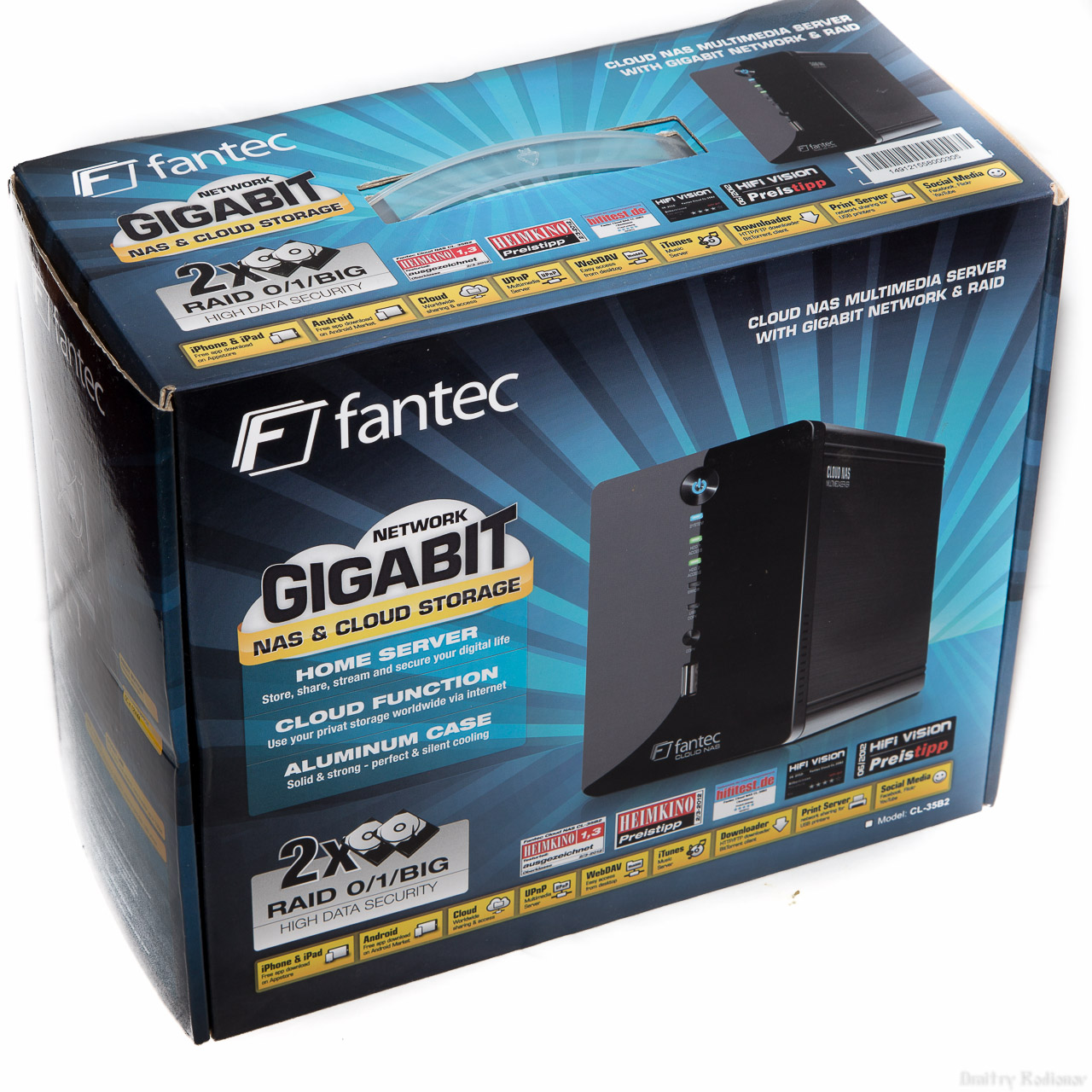 First of all, the device was surprised by its dimensions, I expected to see a significantly larger box. Frankly speaking, I don’t want to talk in detail about the box. Just bring a few photos with an emphasis on technology that Fantec considers it necessary to highlight in your device: support for two hard drives and a gigabit interface.
First of all, the device was surprised by its dimensions, I expected to see a significantly larger box. Frankly speaking, I don’t want to talk in detail about the box. Just bring a few photos with an emphasis on technology that Fantec considers it necessary to highlight in your device: support for two hard drives and a gigabit interface. 
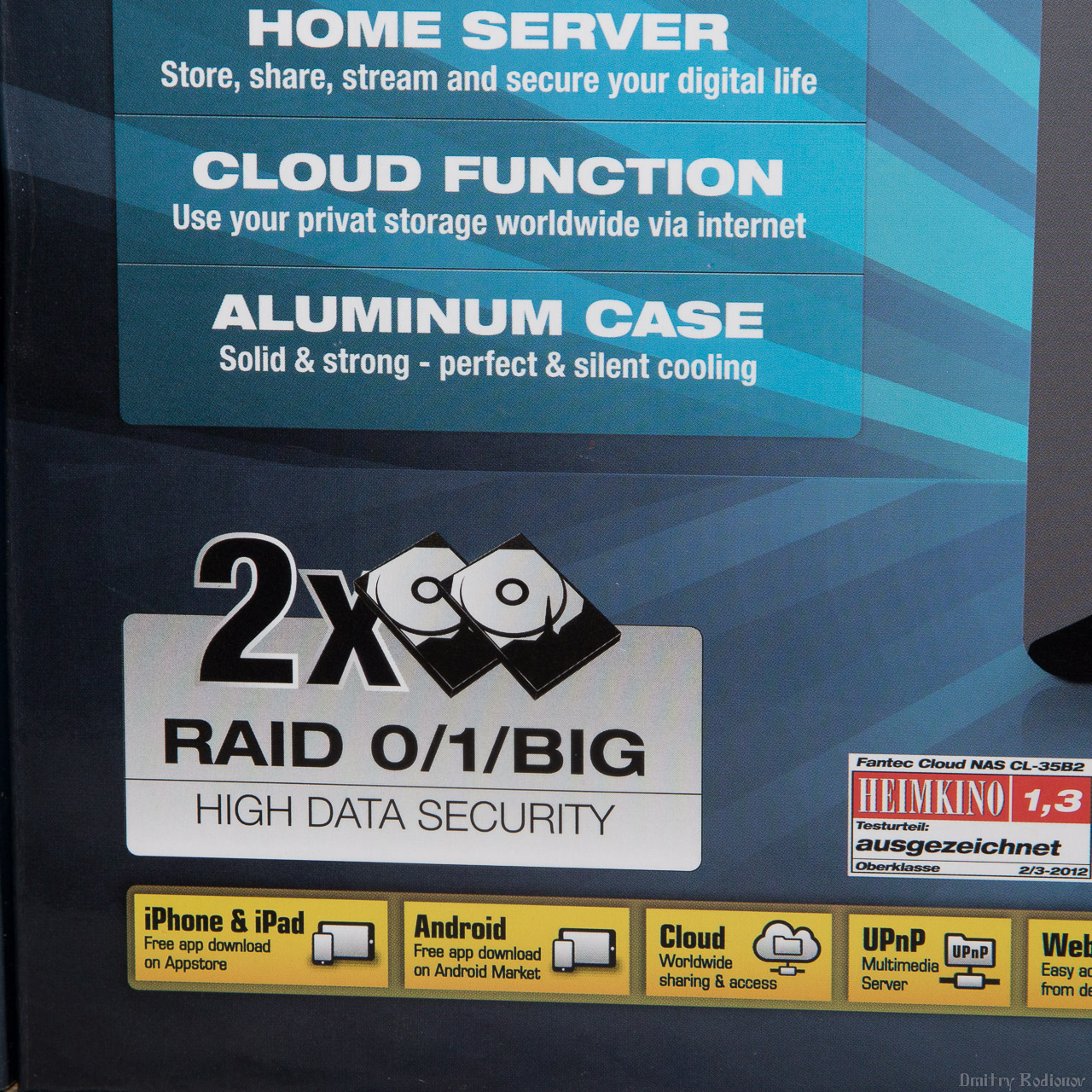

 Packed NAS quality, during transportation is unlikely that something can happen with an empty storage. But in case you order a NAS with installed disks, the mass of the device increases significantly and then the postal services significantly increase their chances to destroy the package.
Packed NAS quality, during transportation is unlikely that something can happen with an empty storage. But in case you order a NAS with installed disks, the mass of the device increases significantly and then the postal services significantly increase their chances to destroy the package.
 Included in the delivery set are the network storage itself, the power adapter, the RJ-45 network cable, a software disk.
Included in the delivery set are the network storage itself, the power adapter, the RJ-45 network cable, a software disk.
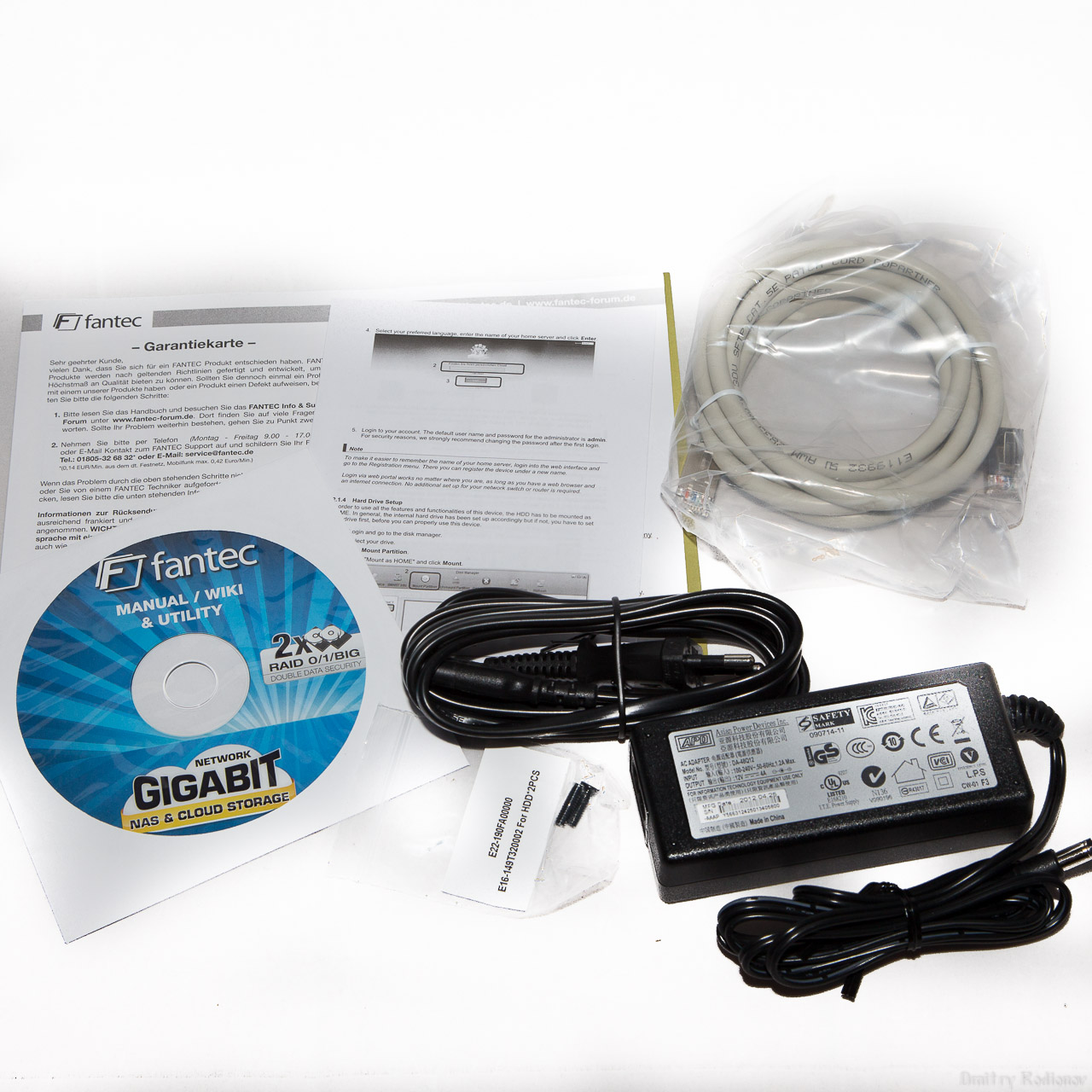 The NAS looks quite nice. The front panel is made of glossy black plastic, the case itself is made of painted aluminum. The solution is quite logical, the case also performs the functions of a radiator for additional cooling of hard drives. The front panel of the network storage is reserved for buttons and indicators. Here are located the power button, the system power indicator, hard disk activity indicators (one for each of the disks), an error indicator, a copy indicator from USB media, a copy button from a USB drive and a USB connector for connecting devices with information.
The NAS looks quite nice. The front panel is made of glossy black plastic, the case itself is made of painted aluminum. The solution is quite logical, the case also performs the functions of a radiator for additional cooling of hard drives. The front panel of the network storage is reserved for buttons and indicators. Here are located the power button, the system power indicator, hard disk activity indicators (one for each of the disks), an error indicator, a copy indicator from USB media, a copy button from a USB drive and a USB connector for connecting devices with information.
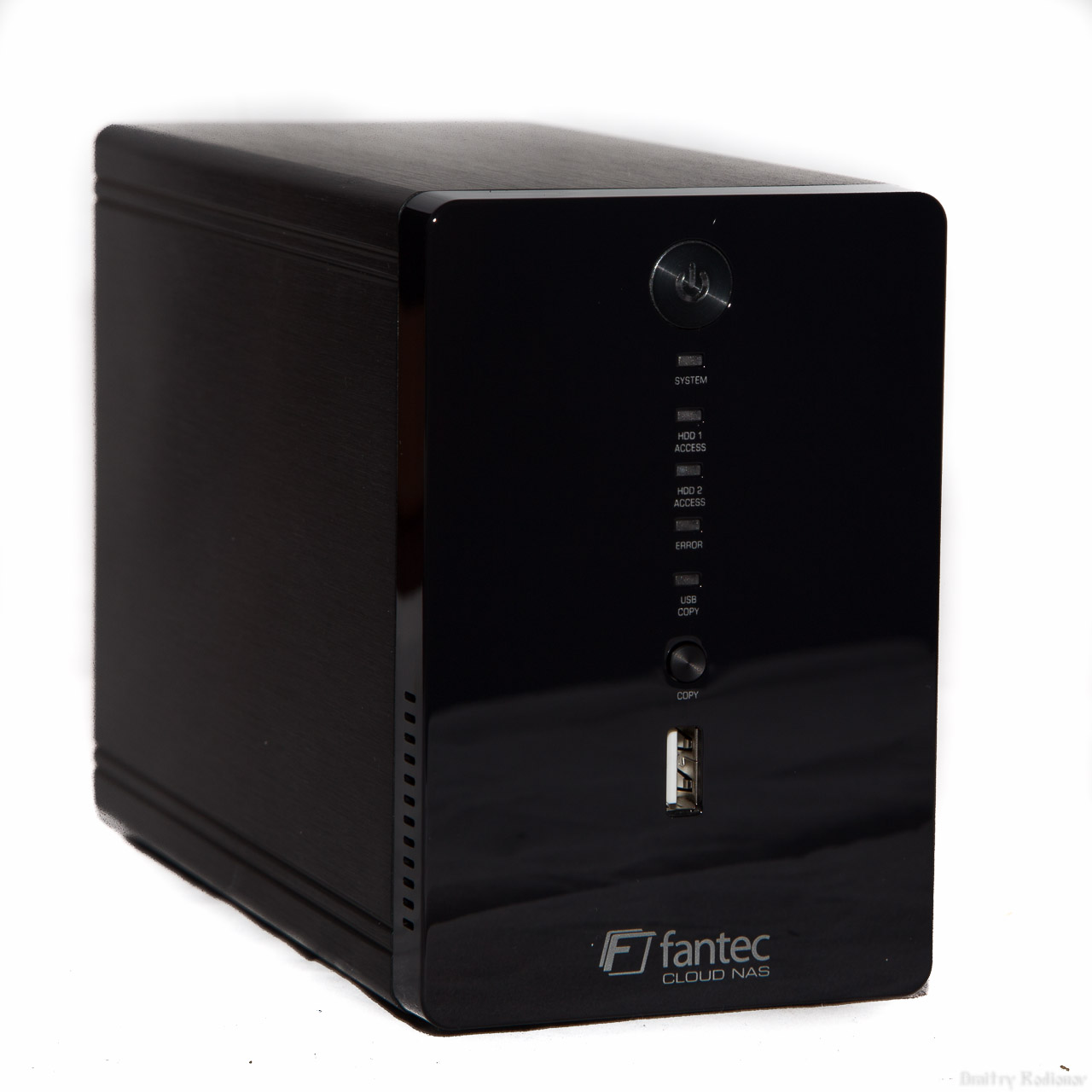 The reverse side of the NAS is reserved for the cooling system fan, the socket for connecting the power supply, the connector for connecting the local network RJ-45, the USB connector, the Reset button and the socket for Kensington lock.
The reverse side of the NAS is reserved for the cooling system fan, the socket for connecting the power supply, the connector for connecting the local network RJ-45, the USB connector, the Reset button and the socket for Kensington lock.
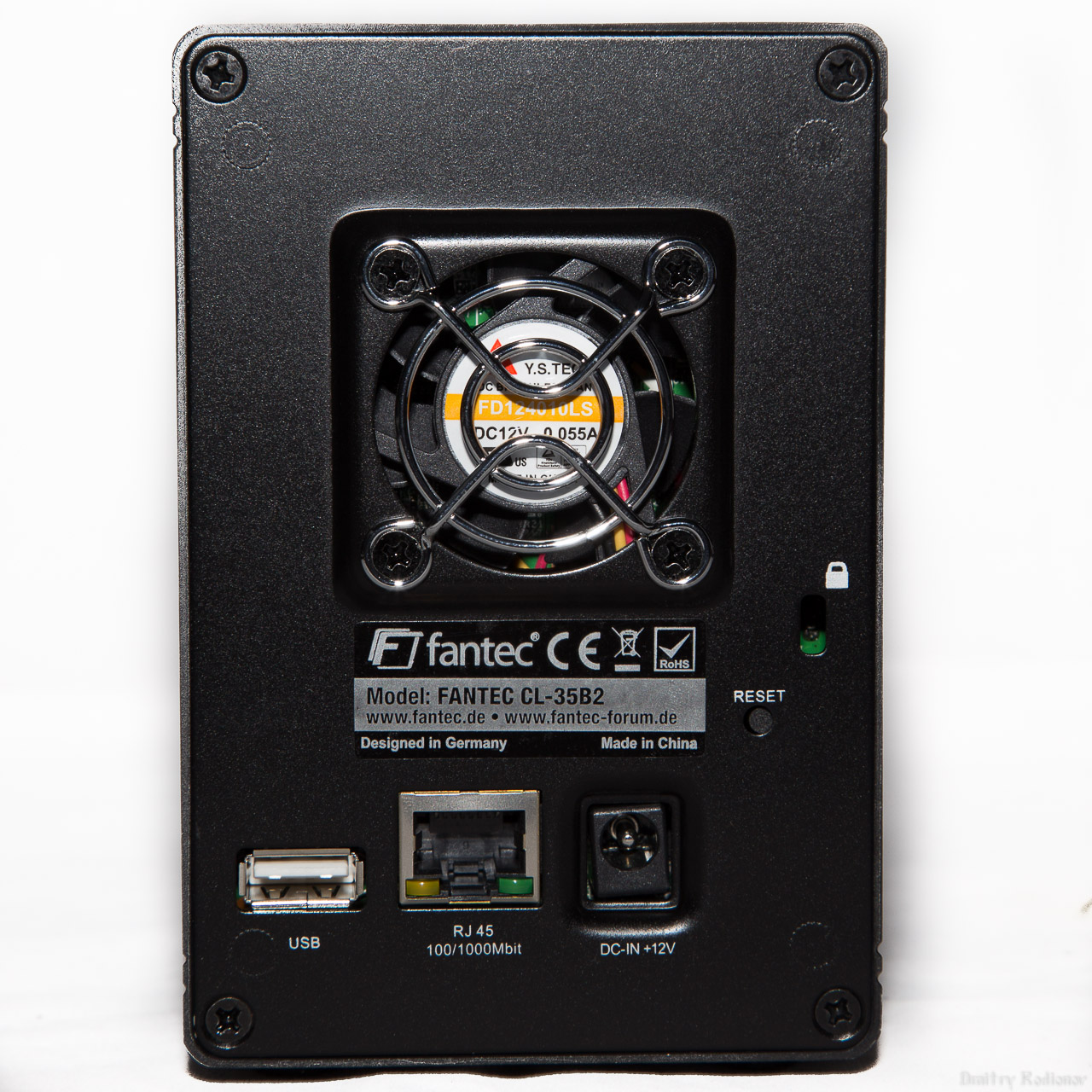 The bottom panel in addition to the rubber feet also contains the elements responsible for the operation of the NAS, namely the latch for the front panel and two holes for fastening the installed hard drives.
The bottom panel in addition to the rubber feet also contains the elements responsible for the operation of the NAS, namely the latch for the front panel and two holes for fastening the installed hard drives.

 After removing the front panel at the end of the tunnel, you can see the board on which the network storage control elements are located.
After removing the front panel at the end of the tunnel, you can see the board on which the network storage control elements are located.

 After the removal of the aluminum case, a rather miserable design remains, not at all resembling network storage or any computer in principle.
After the removal of the aluminum case, a rather miserable design remains, not at all resembling network storage or any computer in principle.
 The basis of NAS Fantec CL-35B2 is a PLX NAS 7821 chip. Accessing Google leads to the manufacturer’s website of this controller: http://www.plxtech.com/products/consumer/nas7821 - you can see the documentation by reference, PLX download whales for development. I have no agreements with the vendor, so we only honor what is available to everyone. Here the first surprises begin, for example, only the SATA 3 Gb / s interface is supported. Not that it was very necessary or the capacity of Gigabit Ethernet allowed to pump more than one gigabit through itself, but nevertheless, I would like to see the SATA III (6 Gbit / s) interface.
The basis of NAS Fantec CL-35B2 is a PLX NAS 7821 chip. Accessing Google leads to the manufacturer’s website of this controller: http://www.plxtech.com/products/consumer/nas7821 - you can see the documentation by reference, PLX download whales for development. I have no agreements with the vendor, so we only honor what is available to everyone. Here the first surprises begin, for example, only the SATA 3 Gb / s interface is supported. Not that it was very necessary or the capacity of Gigabit Ethernet allowed to pump more than one gigabit through itself, but nevertheless, I would like to see the SATA III (6 Gbit / s) interface.  Inside the NAS, however, I will install SATA III drives - specially trained for work in network storages, special training on secret bases and received red stickers - Western Digital WD30EFRX NASware or simply - WD Red.
Inside the NAS, however, I will install SATA III drives - specially trained for work in network storages, special training on secret bases and received red stickers - Western Digital WD30EFRX NASware or simply - WD Red.
 The installation is very simple and seamless - insert the disk with the right side into the compartment (sticker to the center of the NAS) and fix it with one screw from the bottom panel - voila, the NAS is assembled and ready to go.
The installation is very simple and seamless - insert the disk with the right side into the compartment (sticker to the center of the NAS) and fix it with one screw from the bottom panel - voila, the NAS is assembled and ready to go.
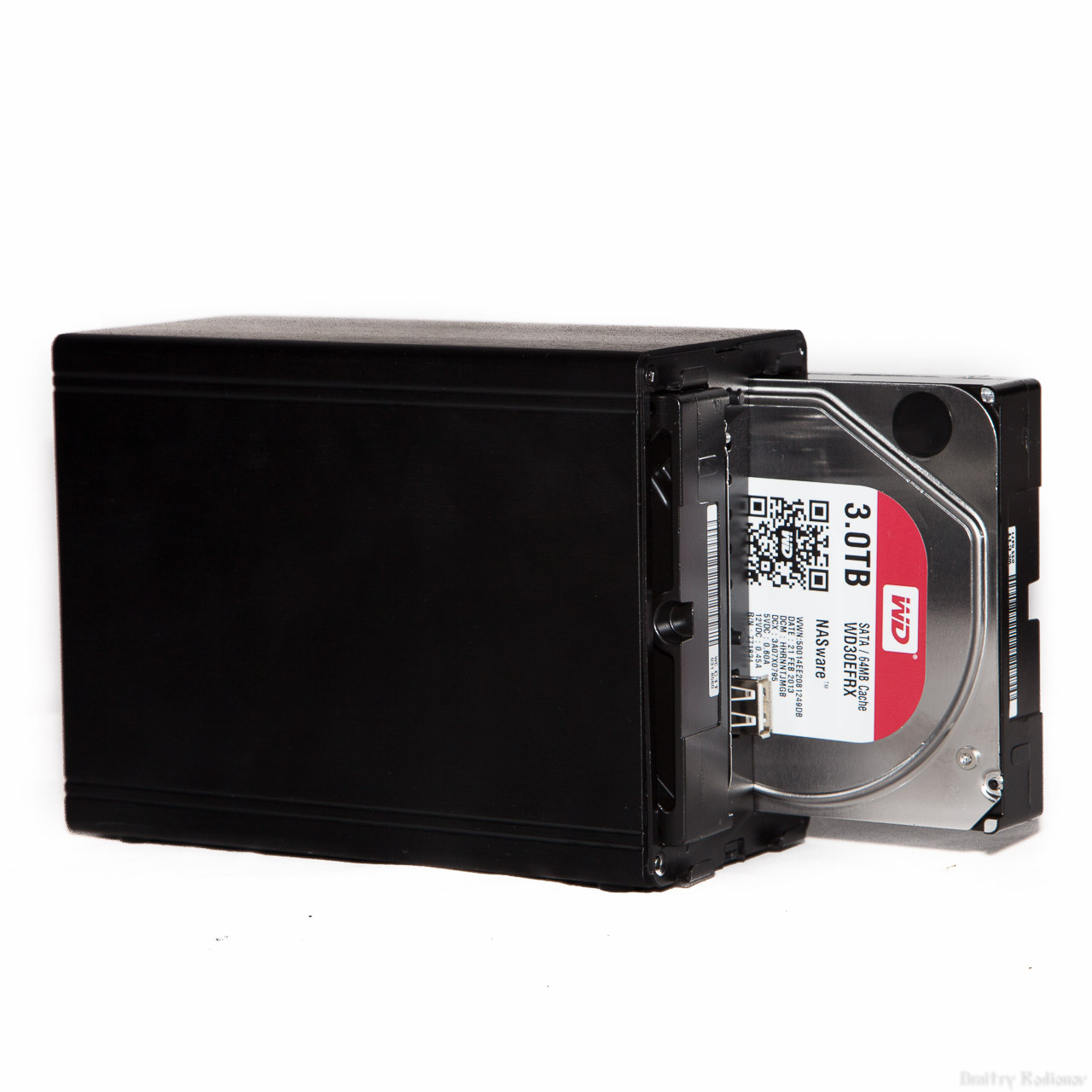 After switching on the network (220V) and network (LAN), the device will be assigned an IP and can access the web interface. Initially, it is proposed to decide which array you want to create from the disks installed in the NAS. I built RAID 1.
After switching on the network (220V) and network (LAN), the device will be assigned an IP and can access the web interface. Initially, it is proposed to decide which array you want to create from the disks installed in the NAS. I built RAID 1.
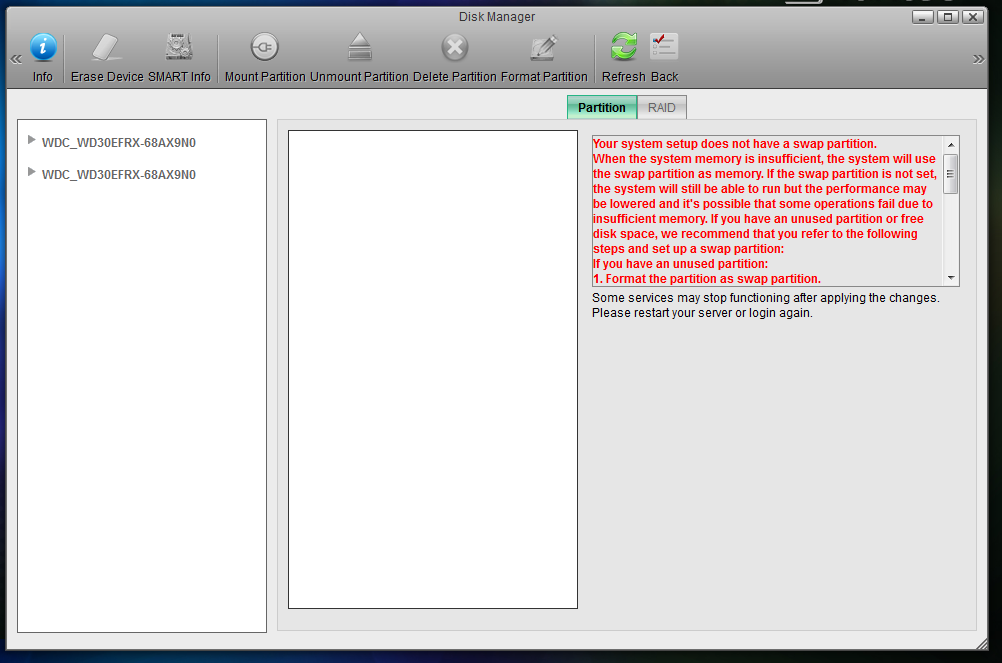
The program for logging into the web interface is called iSharing (here the author was twisted in convulsions, I was only interested in the letter i, which was added to the front of something).

After iSharing found your NAS, the main web interface opens. Linux, like Linux.

I go to MyCloud (well, that is not iMyCloud) - four standard folders Documents, Music, Photo, Video.

Everything is much more interesting in the settings: there is an address book, applications, information and disk management, a media player, various customization options, including the appearance.
There are 11 languages available for the interface, among which there is a great and powerful Russian language.
If you look at the information about the disks, you can see the absolute truth - two 3 TB disks in a RAID 1 array with a total volume of 3 TB.

System information offers a large number of settings in which I personally find the services most interesting.
Great, the media server is on. No complications, everything is very simple and fast. The cinema and music from the root folder is broadcast to a local network and my TV is already ready to show films.
iTunes is also set up simply and the music player is already losing everything that is overwhelmed by overwork.

FTP works without problems, though, to be honest, I don’t use this protocol at home. So, a screenshot for a tick.
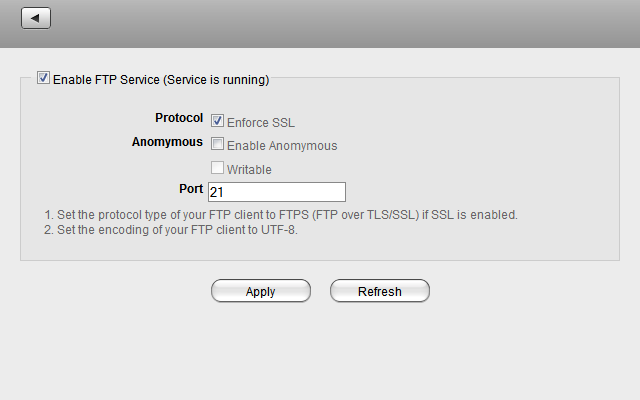
Here is the information about the system. I have nothing to hide here, so look).
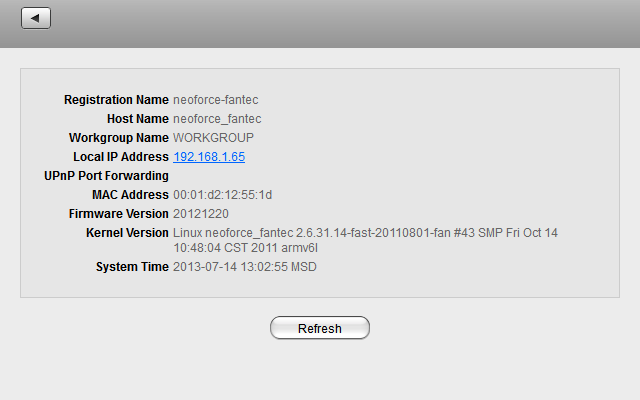
To access the NAS from the Internet, you can register the name on myisharing.com and connect from work to your home storage. The ability to assign an external IP is missing, or at least I did not find it. On QNAP, it is and very easy to configure.

The download wizard has one very unpleasant feature - it only understands http addresses. If you want to download torrents, you need to search and install additional programs.
 So, everything seems to be about the device. I'm still complaining about the software update system. This nontrivial, as it turned out, the task is only for the most persistent users. Automatic update stupidly does not work. The page in English that is sent to download the firmware does not work. And only when surfing on the German version of the site (the benefit of your humble servant a little spinning on this language) managed to get a new firmware. A similar situation occurs with additional modules to improve functionality. Now I will summarize and tell you why the device is not left to live with me. Pros: low price (I found one device in the store for about 6400 rubles), compact size, support for two drives, support for RAID 0/1. Cons: lack of SATA III, lack of ability to assign external IP, lack of innate support for torrents, lack of regular updates. What is critical for me here? Well, first, of course, torrents. The reasons are clear to everyone. Secondly, external IP. Many people have a proxy at work, cutting all sorts of file dumping machines, but they are powerless before simply using IP over a home NAS. These two reasons actually became a reason for parting with Fantec. Scold and say that the thing is not worthwhile, I will not, for a simple file storage at home - it will do, but IMHO no more.
So, everything seems to be about the device. I'm still complaining about the software update system. This nontrivial, as it turned out, the task is only for the most persistent users. Automatic update stupidly does not work. The page in English that is sent to download the firmware does not work. And only when surfing on the German version of the site (the benefit of your humble servant a little spinning on this language) managed to get a new firmware. A similar situation occurs with additional modules to improve functionality. Now I will summarize and tell you why the device is not left to live with me. Pros: low price (I found one device in the store for about 6400 rubles), compact size, support for two drives, support for RAID 0/1. Cons: lack of SATA III, lack of ability to assign external IP, lack of innate support for torrents, lack of regular updates. What is critical for me here? Well, first, of course, torrents. The reasons are clear to everyone. Secondly, external IP. Many people have a proxy at work, cutting all sorts of file dumping machines, but they are powerless before simply using IP over a home NAS. These two reasons actually became a reason for parting with Fantec. Scold and say that the thing is not worthwhile, I will not, for a simple file storage at home - it will do, but IMHO no more.
 First of all, the device was surprised by its dimensions, I expected to see a significantly larger box. Frankly speaking, I don’t want to talk in detail about the box. Just bring a few photos with an emphasis on technology that Fantec considers it necessary to highlight in your device: support for two hard drives and a gigabit interface.
First of all, the device was surprised by its dimensions, I expected to see a significantly larger box. Frankly speaking, I don’t want to talk in detail about the box. Just bring a few photos with an emphasis on technology that Fantec considers it necessary to highlight in your device: support for two hard drives and a gigabit interface. 


 Packed NAS quality, during transportation is unlikely that something can happen with an empty storage. But in case you order a NAS with installed disks, the mass of the device increases significantly and then the postal services significantly increase their chances to destroy the package.
Packed NAS quality, during transportation is unlikely that something can happen with an empty storage. But in case you order a NAS with installed disks, the mass of the device increases significantly and then the postal services significantly increase their chances to destroy the package. Included in the delivery set are the network storage itself, the power adapter, the RJ-45 network cable, a software disk.
Included in the delivery set are the network storage itself, the power adapter, the RJ-45 network cable, a software disk. The NAS looks quite nice. The front panel is made of glossy black plastic, the case itself is made of painted aluminum. The solution is quite logical, the case also performs the functions of a radiator for additional cooling of hard drives. The front panel of the network storage is reserved for buttons and indicators. Here are located the power button, the system power indicator, hard disk activity indicators (one for each of the disks), an error indicator, a copy indicator from USB media, a copy button from a USB drive and a USB connector for connecting devices with information.
The NAS looks quite nice. The front panel is made of glossy black plastic, the case itself is made of painted aluminum. The solution is quite logical, the case also performs the functions of a radiator for additional cooling of hard drives. The front panel of the network storage is reserved for buttons and indicators. Here are located the power button, the system power indicator, hard disk activity indicators (one for each of the disks), an error indicator, a copy indicator from USB media, a copy button from a USB drive and a USB connector for connecting devices with information. The reverse side of the NAS is reserved for the cooling system fan, the socket for connecting the power supply, the connector for connecting the local network RJ-45, the USB connector, the Reset button and the socket for Kensington lock.
The reverse side of the NAS is reserved for the cooling system fan, the socket for connecting the power supply, the connector for connecting the local network RJ-45, the USB connector, the Reset button and the socket for Kensington lock. The bottom panel in addition to the rubber feet also contains the elements responsible for the operation of the NAS, namely the latch for the front panel and two holes for fastening the installed hard drives.
The bottom panel in addition to the rubber feet also contains the elements responsible for the operation of the NAS, namely the latch for the front panel and two holes for fastening the installed hard drives.
 After removing the front panel at the end of the tunnel, you can see the board on which the network storage control elements are located.
After removing the front panel at the end of the tunnel, you can see the board on which the network storage control elements are located.
 After the removal of the aluminum case, a rather miserable design remains, not at all resembling network storage or any computer in principle.
After the removal of the aluminum case, a rather miserable design remains, not at all resembling network storage or any computer in principle. The basis of NAS Fantec CL-35B2 is a PLX NAS 7821 chip. Accessing Google leads to the manufacturer’s website of this controller: http://www.plxtech.com/products/consumer/nas7821 - you can see the documentation by reference, PLX download whales for development. I have no agreements with the vendor, so we only honor what is available to everyone. Here the first surprises begin, for example, only the SATA 3 Gb / s interface is supported. Not that it was very necessary or the capacity of Gigabit Ethernet allowed to pump more than one gigabit through itself, but nevertheless, I would like to see the SATA III (6 Gbit / s) interface.
The basis of NAS Fantec CL-35B2 is a PLX NAS 7821 chip. Accessing Google leads to the manufacturer’s website of this controller: http://www.plxtech.com/products/consumer/nas7821 - you can see the documentation by reference, PLX download whales for development. I have no agreements with the vendor, so we only honor what is available to everyone. Here the first surprises begin, for example, only the SATA 3 Gb / s interface is supported. Not that it was very necessary or the capacity of Gigabit Ethernet allowed to pump more than one gigabit through itself, but nevertheless, I would like to see the SATA III (6 Gbit / s) interface.  Inside the NAS, however, I will install SATA III drives - specially trained for work in network storages, special training on secret bases and received red stickers - Western Digital WD30EFRX NASware or simply - WD Red.
Inside the NAS, however, I will install SATA III drives - specially trained for work in network storages, special training on secret bases and received red stickers - Western Digital WD30EFRX NASware or simply - WD Red. The installation is very simple and seamless - insert the disk with the right side into the compartment (sticker to the center of the NAS) and fix it with one screw from the bottom panel - voila, the NAS is assembled and ready to go.
The installation is very simple and seamless - insert the disk with the right side into the compartment (sticker to the center of the NAS) and fix it with one screw from the bottom panel - voila, the NAS is assembled and ready to go. After switching on the network (220V) and network (LAN), the device will be assigned an IP and can access the web interface. Initially, it is proposed to decide which array you want to create from the disks installed in the NAS. I built RAID 1.
After switching on the network (220V) and network (LAN), the device will be assigned an IP and can access the web interface. Initially, it is proposed to decide which array you want to create from the disks installed in the NAS. I built RAID 1.
The program for logging into the web interface is called iSharing (here the author was twisted in convulsions, I was only interested in the letter i, which was added to the front of something).

After iSharing found your NAS, the main web interface opens. Linux, like Linux.

I go to MyCloud (well, that is not iMyCloud) - four standard folders Documents, Music, Photo, Video.

Everything is much more interesting in the settings: there is an address book, applications, information and disk management, a media player, various customization options, including the appearance.

There are 11 languages available for the interface, among which there is a great and powerful Russian language.

If you look at the information about the disks, you can see the absolute truth - two 3 TB disks in a RAID 1 array with a total volume of 3 TB.

System information offers a large number of settings in which I personally find the services most interesting.

Great, the media server is on. No complications, everything is very simple and fast. The cinema and music from the root folder is broadcast to a local network and my TV is already ready to show films.

iTunes is also set up simply and the music player is already losing everything that is overwhelmed by overwork.

FTP works without problems, though, to be honest, I don’t use this protocol at home. So, a screenshot for a tick.

Here is the information about the system. I have nothing to hide here, so look).

To access the NAS from the Internet, you can register the name on myisharing.com and connect from work to your home storage. The ability to assign an external IP is missing, or at least I did not find it. On QNAP, it is and very easy to configure.

The download wizard has one very unpleasant feature - it only understands http addresses. If you want to download torrents, you need to search and install additional programs.
 So, everything seems to be about the device. I'm still complaining about the software update system. This nontrivial, as it turned out, the task is only for the most persistent users. Automatic update stupidly does not work. The page in English that is sent to download the firmware does not work. And only when surfing on the German version of the site (the benefit of your humble servant a little spinning on this language) managed to get a new firmware. A similar situation occurs with additional modules to improve functionality. Now I will summarize and tell you why the device is not left to live with me. Pros: low price (I found one device in the store for about 6400 rubles), compact size, support for two drives, support for RAID 0/1. Cons: lack of SATA III, lack of ability to assign external IP, lack of innate support for torrents, lack of regular updates. What is critical for me here? Well, first, of course, torrents. The reasons are clear to everyone. Secondly, external IP. Many people have a proxy at work, cutting all sorts of file dumping machines, but they are powerless before simply using IP over a home NAS. These two reasons actually became a reason for parting with Fantec. Scold and say that the thing is not worthwhile, I will not, for a simple file storage at home - it will do, but IMHO no more.
So, everything seems to be about the device. I'm still complaining about the software update system. This nontrivial, as it turned out, the task is only for the most persistent users. Automatic update stupidly does not work. The page in English that is sent to download the firmware does not work. And only when surfing on the German version of the site (the benefit of your humble servant a little spinning on this language) managed to get a new firmware. A similar situation occurs with additional modules to improve functionality. Now I will summarize and tell you why the device is not left to live with me. Pros: low price (I found one device in the store for about 6400 rubles), compact size, support for two drives, support for RAID 0/1. Cons: lack of SATA III, lack of ability to assign external IP, lack of innate support for torrents, lack of regular updates. What is critical for me here? Well, first, of course, torrents. The reasons are clear to everyone. Secondly, external IP. Many people have a proxy at work, cutting all sorts of file dumping machines, but they are powerless before simply using IP over a home NAS. These two reasons actually became a reason for parting with Fantec. Scold and say that the thing is not worthwhile, I will not, for a simple file storage at home - it will do, but IMHO no more.')
Source: https://habr.com/ru/post/192106/
All Articles